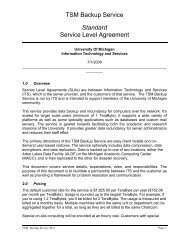What documentation exists for R?
What documentation exists for R?
What documentation exists for R?
You also want an ePaper? Increase the reach of your titles
YUMPU automatically turns print PDFs into web optimized ePapers that Google loves.
Chapter 7: R Miscellanea 81<br />
R> test1()<br />
3 3.14<br />
R> test2()<br />
3 3.141593<br />
<strong>What</strong> is really used is the global value of .Options, and using options(OPT = VAL)<br />
correctly updates it. Local copies of .Options, either in .GlobalEnv or in a function<br />
environment (frame), are just silently disregarded.<br />
7.8 How do file names work in Windows?<br />
As R uses C-style string handling, ‘\’ is treated as an escape character, so that <strong>for</strong> example<br />
one can enter a newline as ‘\n’. When you really need a ‘\’, you have to escape it with<br />
another ‘\’.<br />
Thus, in filenames use something like "c:\\data\\money.dat". You can also replace<br />
‘\’ by ‘/’ ("c:/data/money.dat").<br />
7.9 Why does plotting give a color allocation error?<br />
On an X11 device, plotting sometimes, e.g., when running demo("image"), results in “Error:<br />
color allocation error”. This is an X problem, and only indirectly related to R. It occurs<br />
when applications started prior to R have used all the available colors. (How many colors<br />
are available depends on the X configuration; sometimes only 256 colors can be used.)<br />
One application which is notorious <strong>for</strong> “eating” colors is Netscape. If the problem occurs<br />
when Netscape is running, try (re)starting it with either the ‘-no-install’ (to use the<br />
default colormap) or the ‘-install’ (to install a private colormap) option.<br />
You could also set the colortype of X11() to "pseudo.cube" rather than the default<br />
"pseudo". See the help page <strong>for</strong> X11() <strong>for</strong> more in<strong>for</strong>mation.<br />
7.10 How do I convert factors to numeric?<br />
It may happen that when reading numeric data into R (usually, when reading in a file),<br />
they come in as factors. If f is such a factor object, you can use<br />
as.numeric(as.character(f))<br />
to get the numbers back. More efficient, but harder to remember, is<br />
as.numeric(levels(f))[as.integer(f)]<br />
In any case, do not call as.numeric() or their likes directly <strong>for</strong> the task at hand (as<br />
as.numeric() or unclass() give the internal codes).<br />
7.11 Are Trellis displays implemented in R?<br />
The recommended package lattice (which is based on another recommended package, grid)<br />
provides graphical functionality that is compatible with most Trellis commands.<br />
You could also look at coplot() and dotchart() which might do at least some of what<br />
you want. Note also that the R version of pairs() is fairly general and provides most of the<br />
functionality of splom(), and that R’s default plot method has an argument asp allowing<br />
to specify (and fix against device resizing) the aspect ratio of the plot.








